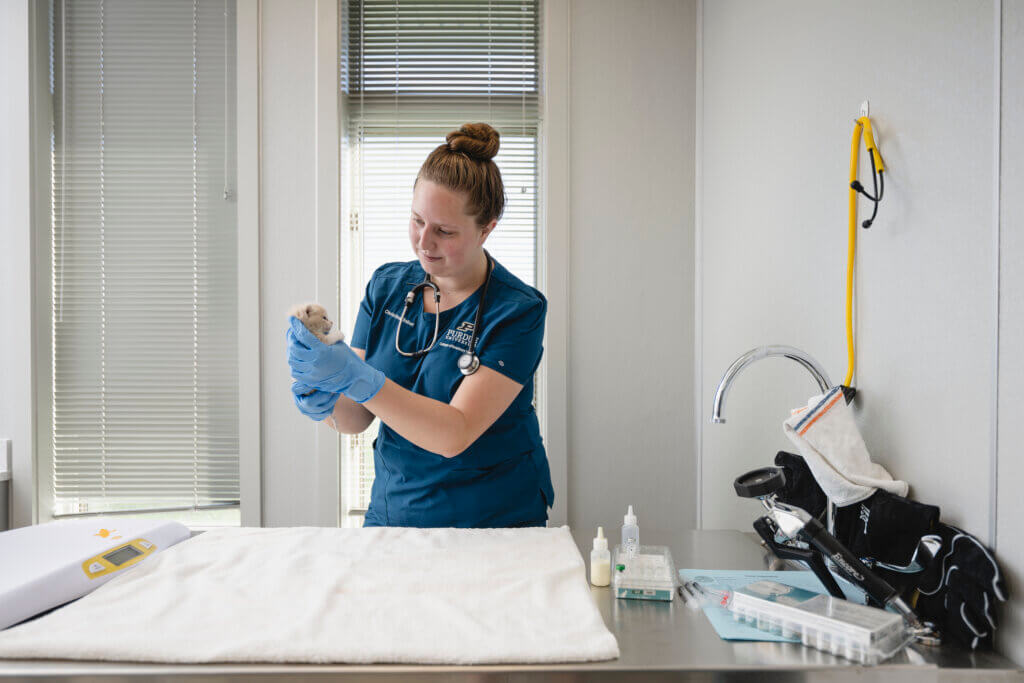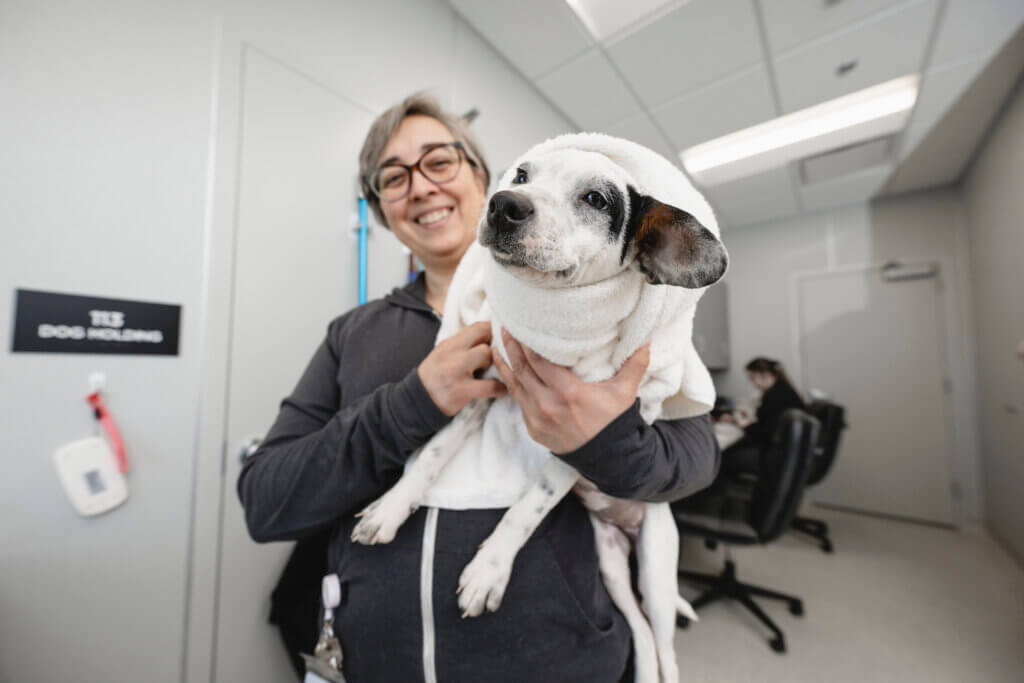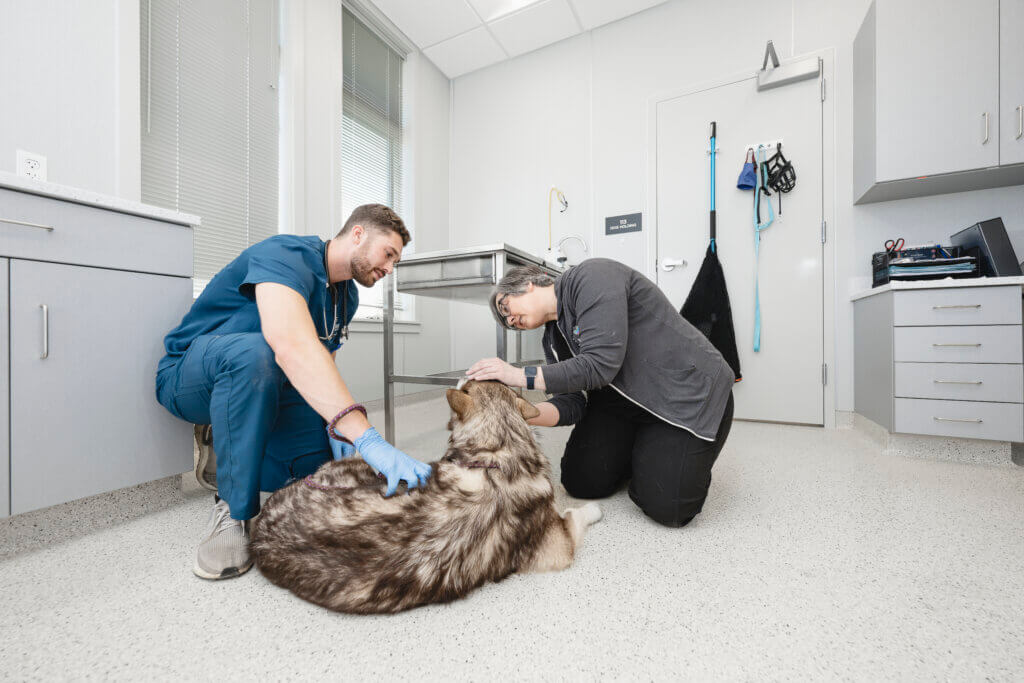As three fourth-year veterinary students walk up to the newly opened Humane Society for Greater Lafayette (HS4GL), Dr. Jessica Snyder greets them at the door.
“Good morning,” she says. “We have about 20 intakes for you to process today.”
The students are the first cohort to participate in a three-week clinical rotation in shelter medicine that incorporates visits to HS4GL. The cats and dogs they examine are among the first to be taken in by this shelter, which opened its doors in September. When planning for a new animal shelter began a few years back, faculty at Purdue University’s College of Veterinary Medicine collaborated with civic leaders to form a partnership that would allow veterinary students to partake in clinical rotations at the shelter, gaining valuable hands-on experience in examinations, treatment and surgery.
Priority 4 Paws
In August, Purdue hired Dr. Snyder as a staff veterinarian with an appointment as medical director of the shelter. This arrangement facilitates a satellite site at the shelter that serves as an extension of the Priority 4 Paws shelter medicine program at Purdue.
The program began in 2012 as a mobile surgery unit that traveled to shelters and rescue groups within a two-hour radius of campus to provide treatment and perform operations. Once the Brunner Purdue Veterinary Medical Hospital Complex opened in 2022, Priority 4 Paws found a permanent home in vacated space in Lynn Hall.
“Having our own space has enabled us to grow the shelter medicine program because we have more physical space to teach more students,” said Dr. Emily Curry, clinical assistant professor of shelter medicine and surgery. “We understand that most of our students will not become shelter veterinarians. They’ll likely be general practitioners. But during their rotation, we want to impress upon them that no matter where you practice or how you practice, you can be part of the solution of reducing the number of animals who end up in shelters.”
Priority 4 Paws provides standard care such as wellness examinations, vaccinations, heartworm prevention and flea and tick prevention free-of-charge to its dozen or so shelter partners. Although most of the patients treated through the program are brought to campus by their respective shelter or rescue group, students do sometimes visit shelter sites as part of the rotation. In those instances, they must be accompanied by Dr. Curry or Dr. Ryan Hill, clinical assistant professor of shelter medicine, as most small or rural shelters do not have veterinarians on staff.

“To have a permanent satellite location with the Humane Society for Greater Lafayette with an onsite medical director is really exciting,” Dr. Curry said. “I’ve known Dr. Snyder for quite some time and she’s taught me so much in the realm of shelter medicine and surgery. She’s also taught our students through different opportunities. When I learned she was interested in this new position at the shelter, I knew she’d be the perfect fit for the program.”
For Dr. Snyder, the position is a dream job. After beginning her veterinary career in general practice, she decided to dedicate herself to shelter medicine. She previously worked at two other humane societies in central Indiana as well as a nonprofit low-cost spay and neuter clinic.

“The opportunity to serve as medical director and practice shelter medicine while also teaching veterinary students is the best of both worlds,” Dr. Snyder said. “Shelter medicine is not just about treating an individual animal, it’s very much an issue of herd health. By working in a shelter setting and seeing all 180 animals we are caring for, it broadens students’ perspectives on the public aspect of companion animal health.”
An Advocate for Animals
Back at the shelter, student Patrick Flaherty, of the DVM Class of 2025, is coaxing a skittish red husky from her kennel and into the exam room. She’s spayed and her fluffy brown and white coat is well-groomed, indicating she may be someone’s runaway pet. She was one of several strays picked up by animal control over the weekend. Flaherty sits on the floor to comfort the dog as he checks her ears, eyes and teeth, estimating her age to be about one and a half years old.
“I’m thinking of naming her after a character in Game of Thrones,” Flaherty says. “But not Cersei. That name is way overdone.”
Fellow student Christina Sabat suggests the name Swiss Miss. Once she’s spoken it, everyone in the room concurs. This dog looks like a Swiss Miss.
“Okay,” Flaherty says as he scratches her ears.
“Swiss Miss it is.”
Naming the unknown animals that come to the shelter may be one of the most fun aspects of the job, but it serves a larger purpose beyond easy identification. Giving an animal a name is also a means of advocating for that animal, its dignity and care.
“The reason I’m in shelter medicine is because these animals don’t have an advocate,” Dr. Snyder said. “They need to have someone working toward their eventual healing, reunification or adoption. I want to ensure these animals are receiving the best standard of care on both an individual and herd level.”
Students working at HS4GL conduct wellness examinations, administer vaccines and medicine, and perform surgeries. The facility’s surgical suite was outfitted by Purdue — everything from the medical equipment and monitors to the lights and the surgical table.

One of the things that makes the shelter medicine rotation unique among clinical experiences, is that students take a more active hands-on role in surgeries. In other clinical settings, there may be a team of attending veterinarians, veterinary residents, and veterinary nurses. It can get crowded around the operating table.
“Making decisions, performing surgeries and administering treatments at the shelter builds confidence in the students,” said Dr. Hill, who worked in shelter medicine in Salt Lake City for almost a decade before joining the Purdue faculty in 2022. “It helps them recognize that they know more than they think they do. The types of cases students see during their shelter medicine rotation are the same types of cases they will primarily see in general practice.”
Students will have the opportunity to administer anesthesia and perform common soft tissue surgeries such as spay and neuter procedures, enucleations, hernia repairs and mass removals. Although students will take the lead, Dr. Snyder will be at their side, ready to answer questions or assist as needed. And although they may not choose a career in shelter medicine, she hopes their experience at the shelter not only broadens their perspective but also equips them with skills they can implement no matter their career path.
“I want students to leave here understanding the role of shelter medicine within the spectrum of care,” Dr. Snyder said. “We have a different ability to practice medicine depending on the location, but it is not a different standard of medicine. We still practice the best medicine we can for an animal within limitations.
“Those limitations are going to vary everywhere you go. In a shelter setting, you face limitations on capacity for holding animals, limitations on funding, limitations on specialized equipment — showing students you can practice very good medicine in a limited environment is our goal.”

